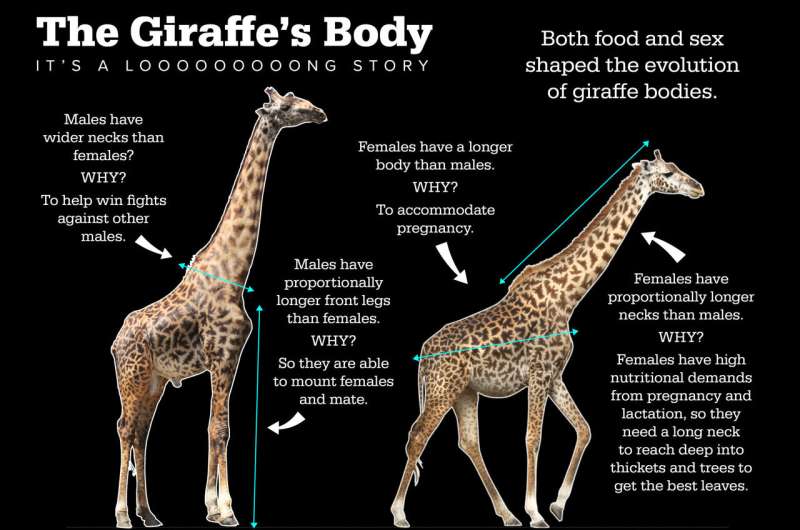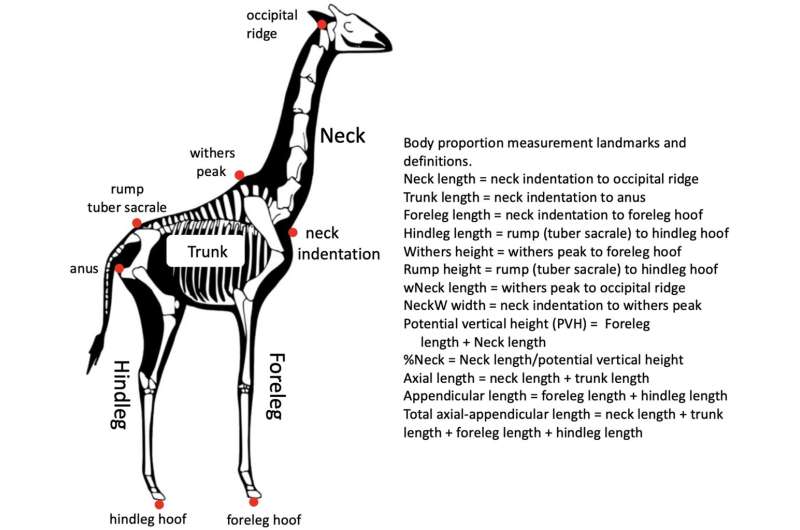This article has been reviewed according to Science X's editorial process and policies. Editors have highlighted the following attributes while ensuring the content's credibility:
fact-checked
peer-reviewed publication
trusted source
proofread
Food, not sex, drove the evolution of giraffes' long neck, new study finds

Why do giraffes have such long necks? A study led by Penn State biologists explores how this trait might have evolved and lends new insight into this iconic question. The reigning hypothesis is that competition among males influenced neck length, but the research team found that female giraffes have proportionally longer necks than males—suggesting that high nutritional needs of females may have driven the evolution of this trait.
The study, which explored body proportions of both wild and captive giraffes, is described in a paper that appeared today, June 3, in the journal Mammalian Biology. The findings, the team said, indicate that neck length may be the result of females foraging deeply into trees for otherwise difficult-to-reach leaves.
In their classic theories of evolution, both Jean Baptiste Lamarck and Charles Darwin suggested that giraffes' long necks evolved to help them reach leaves high up in a tree, avoiding competition with other herbivores.
However, a more recent hypothesis called "necks-for-sex" suggests that the evolution of long necks was driven by competition among males, who swing their necks into each other to assert dominance, called neck sparring. That is, males with longer necks might have been more successful in the competition, leading to reproducing and passing their genes to offspring.
"The necks-for-sex hypothesis predicted that males would have longer necks than females," said Doug Cavener, Dorothy Foehr Huck and J. Lloyd Huck Distinguished Chair in Evolutionary Genetics and professor of biology at Penn State and lead author of the study.
"And technically they do have longer necks, but everything about males is longer; they are 30% to 40% bigger than females. In this study, we analyzed photos of hundreds of wild and captive Masai giraffes to investigate the relative body proportions of each species and how they might change as giraffes grow and mature."
The researchers gathered thousands of photos of captive Masai giraffes from the publicly accessible photo repositories Flickr and SmugMug as well as photos of wild adult animals that they have taken over the past decade.
Because absolute measurements like overall height are difficult to determine from a photograph without a point of reference of known length, the researchers instead focused on measurements relative to one another, or body proportions—for example, the length of the neck relative to the entire height of the animal. They restricted their analysis to images that met strict criteria, such as only using images of giraffes perpendicular to the camera, so they could consistently take a variety of measurements.
"We can identify individual giraffes by their unique spot pattern," Cavener said. "Thanks to the Association of Zoos and Aquariums, we also have the full pedigree, or family tree, of all Masai giraffes in North America in zoos and wildlife parks, as well as their birthdates and transfer history.
"So, by carefully considering this information, when the photo was taken and the approximate age of the animal, we could identify the specific individual in nearly every photo of a captive giraffe. This information was critical to understanding when male and female giraffes start to exhibit size differences and whether they grow differently."

At birth, male and female giraffes have the same body proportions. The researchers found that, although males generally grow faster in the first year, body proportions are not significantly different until they start to research sexual maturity around three years of age. Because body proportions change early in life, the team limited their study of wild animals—whose ages are largely unknown—to fully grown adults.
In adult giraffes, the researchers found that females have proportionally longer necks and trunks—or the main section of their body, which does not include legs or the neck and head. Adult males, on the other hand, have longer forelegs and wider necks. This pattern was the same in both captive and wild giraffes.
"Rather than stretching out to eat leaves on the tallest branches, you often see giraffes—especially females—reaching deep into the trees," Cavener said. "Giraffes are picky eaters—they eat the leaves of only a few tree species, and longer necks allow them to reach deeper into the trees to get the leaves no one else can. Once females reach four or five years of age, they are almost always pregnant and lactating, so we think the increased nutritional demands of females drove the evolution of giraffes' long necks."
The researchers noted that sexual selection—either competition among males or preference among females for larger mates—was likely responsible for the overall size difference between males and females, as is the case in many other large, hoofed mammals that are polygynous—where one male mates with many females.
They suggest that, following the evolution of the long neck, sexual selection—including male body pushing and neck sparring behaviors—may have contributed to males' wider necks. Additionally, the longer forelegs of males may assist in mating, which the researchers said is a brief and challenging affair that is rarely observed.
"Interestingly, giraffes are one of few animals whose height we measure to the top of the head—like humans—rather than to their withers—the highest part of the back, like in horses and other livestock," Cavener said. "The female has a proportionally longer axial skeleton—a longer neck and trunk—and are more sloped in appearance, while the males are more vertical."
The research team is also using genetics to identify relationships in groups of wild giraffes to better understand which males are successful at breeding. The goal is to shed additional light on mate choice and sexual selection, as well as guide conservation efforts for this endangered species.
"If female foraging is driving this iconic trait as we suspect, it really highlights the importance of conserving their dwindling habitat," Cavener said. "Populations of Masai giraffes have declined rapidly in the last 30 years, in part due to habitat loss and poaching, and it is critical that we understand the key aspects of their ecology and genetics in order to devise the most efficacious conservation strategies to save these majestic animals."
In addition to Cavener, the research team at Penn State includes Monica Bond, academic affiliate of biology; Lan Wu-Cavener, academic affiliate of biology; George Lohay, a postdoctoral researcher at the time of the research who is now at the Grumeti Fund; Mia Cavener, a graduate student at the time of the research; Xiaoyi Hou, graduate student in the Molecular, Cellular, and Integrative Biosciences program; David Pearce, an undergraduate student at the time of the research; and Derek Lee, academic affiliate of biology.
More information: Douglas R. Cavener et al, Sexual dimorphisms in body proportions of Masai giraffes and the evolution of the giraffe's neck, Mammalian Biology (2024). DOI: 10.1007/s42991-024-00424-4
Journal information: Mammalian Biology
Provided by Pennsylvania State University




















